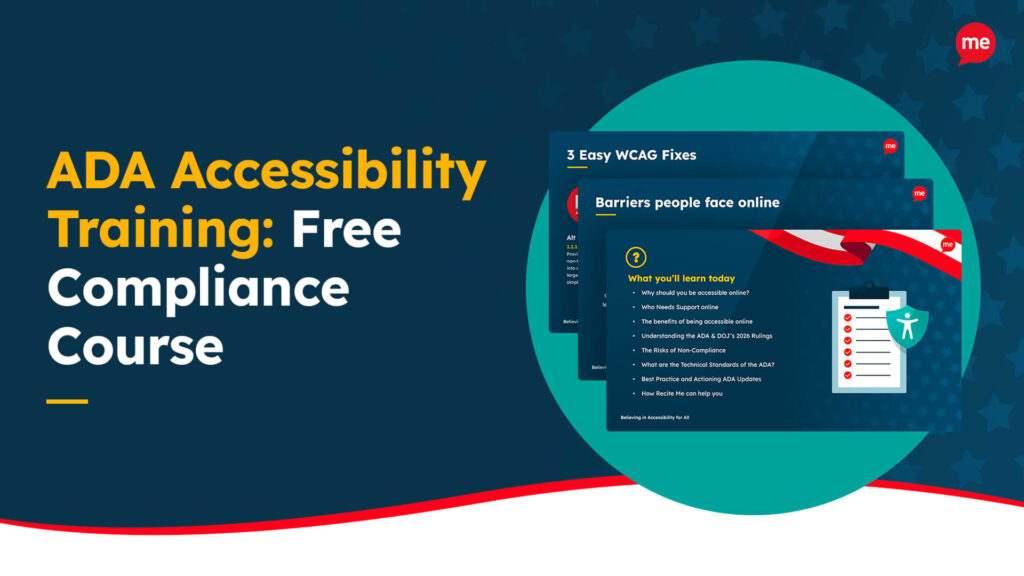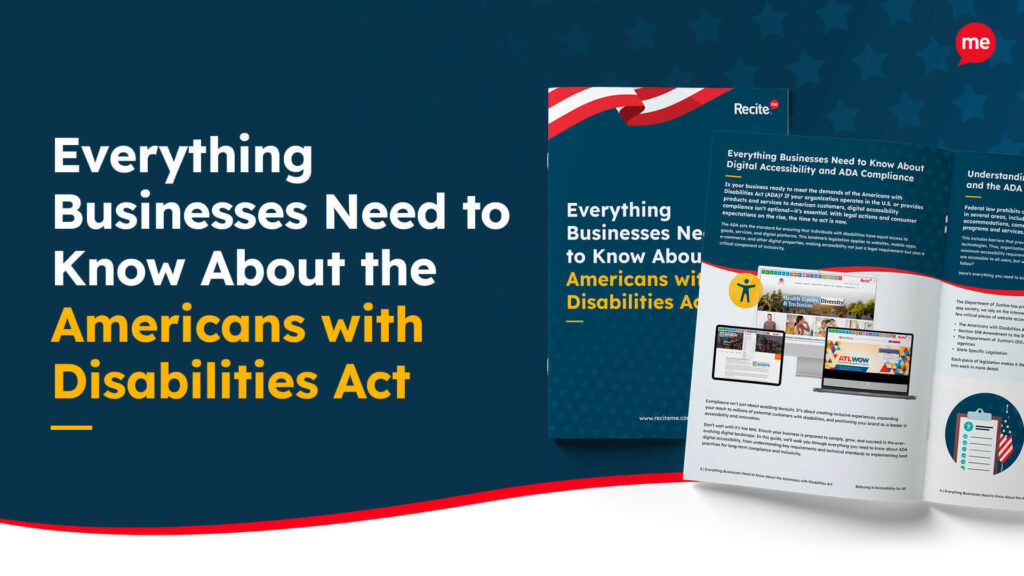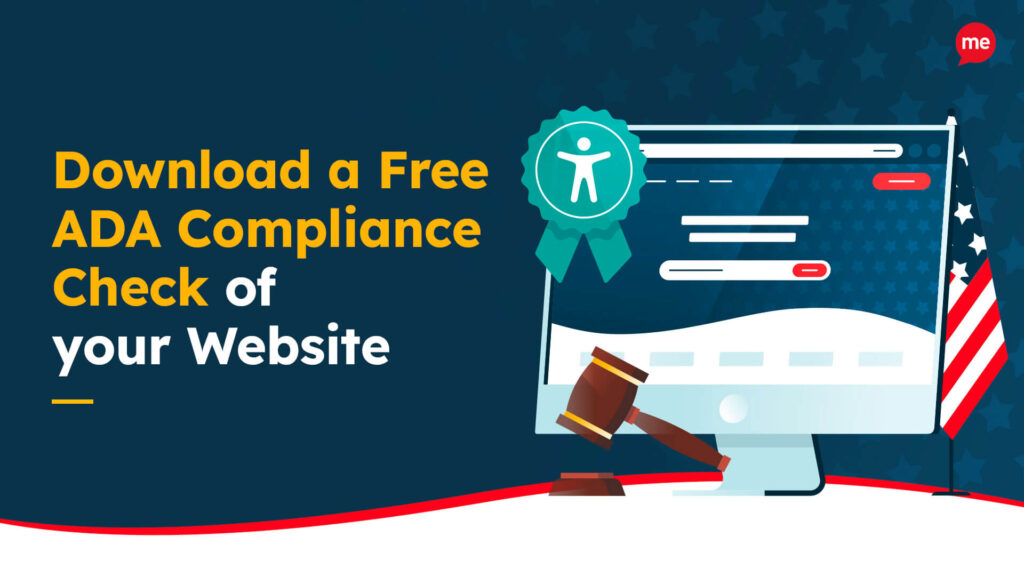Get A Free ADA Compliance Audit Of Your Website
Download NowADA is an important piece of legislation in the United States that protects the rights of people with disabilities. ADA Compliance for eCommerce websites is now mandatory and must be adhered to by businesses operating in the US. So if you own or manage an eCommerce store then it’s in your best interest to ensure ADA compliance or risk the consequences!
In this guide we’ll cover everything you need to know about creating an ADA-compliant eCommerce store, what the benefits and risks are, why it’s important to be compliant and more.
What is ADA Compliance?
ADA Compliance refers to the adherence to the Americans with Disabilities Act (ADA), a civil rights law enacted in 1990 aimed at preventing discrimination based on disability. ADA Compliance ensures that individuals with disabilities have equal access to public services, employment, transportation, and public accommodations, which includes physical spaces, communications, and digital environments such as websites and mobile applications.

Why is ADA Compliance Important for eCommerce Websites?
The importance of an ADA-compliant eCom store can not be underestimated. There’s three primary reasons behind the importance of following ADA guidelines, these are as follows:
#1 The Right Thing to do
Everyone should have the opportunity to access online stores, browse products and make purchases. Making your store ADA compliant supports inclusivity and allows users with disabilities to access your website.
#2 The Smart Thing to do
Around 1 in 4 Americans have a disability, which presents a huge opportunity for businesses to capitalize on in terms of lost revenue. If your store is inaccessible to people with disabilities, then they won’t be able to use your website or make a purchase.
#3 The Thing I must do
For many eCommerce websites operating in the United States ADA compliance is a necessity. Becoming compliant helps to mitigate against the likelihood of an ADA website lawsuit and avoid any negative customer sentiment.
Checking if your eCommerce Website is ADA-compliant
The introduction of accessibility scanning tools such as our Accessibility Checker provide a fast and efficient way to identify inaccessible and non-compliant ADA web design.
Simply enter your website URL into the tool and it will produce a free accessibility scan of your website. This scan will begin to audit your website on the basis of the WCAG guidelines, which are the fundamental building blocks of ADA compliance. When the scan is complete, you’ll be provided with an accessibility rating, any inaccessible features will be outlined with recommendations as to how you can resolve them.
As you begin to address and resolve any accessibility issues you can track your progress in the tool. As your accessibility score begins to increase you’ll be able to download reports from the tool that you can share with your colleagues, peers and customers to showcase your journey to ADA Compliance.
Get a free automated ADA compliance audit of your website. This audit will highlight compliance violations and provide the recommendations needed to meet ADA compliance standards.
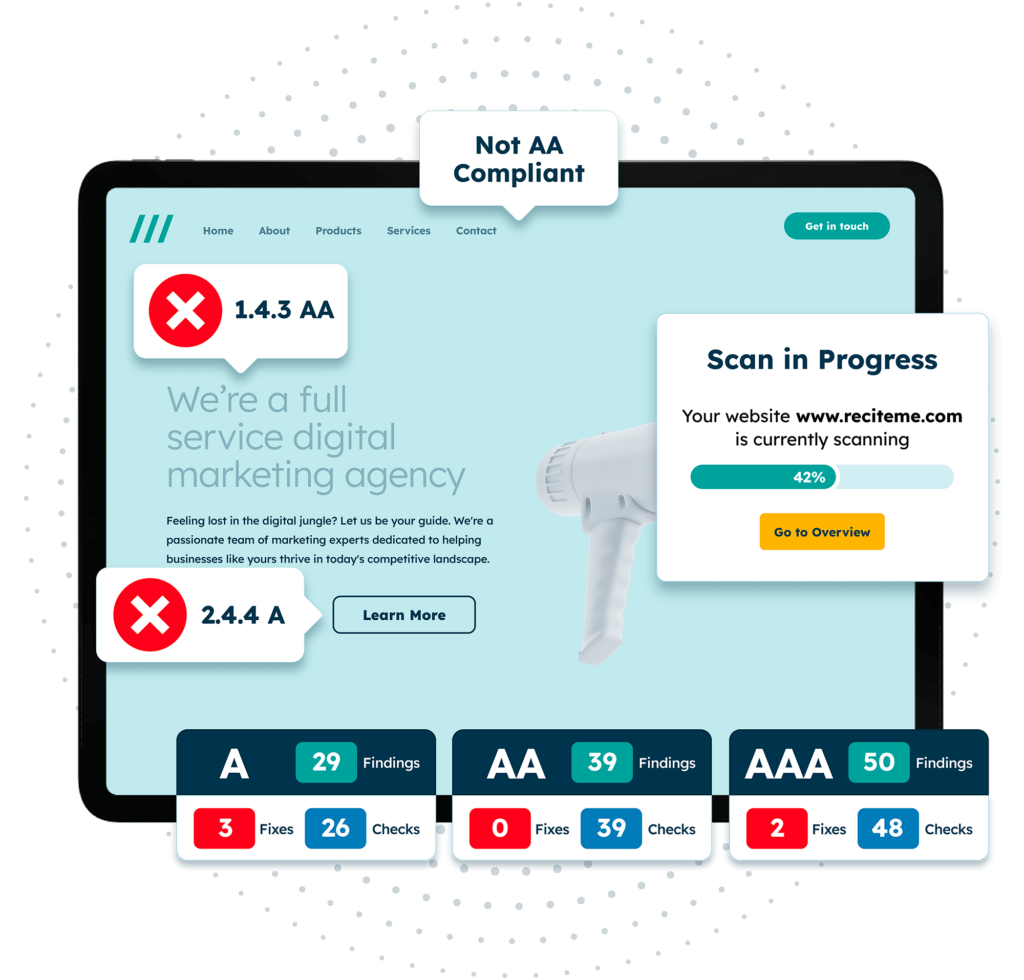
What to do if your Website is not Compliant with ADA Laws?
If you’ve detected issues with the inclusivity of your eCom store, then you can begin actioning the necessary steps to improve your compliance. There are four key principles you should focus on addressing when it comes to eCommerce design if you want to be compliant with ADA laws. These include:
- Be easy to perceive – Information on your website should be readily available in all formats. Alt text for images, transcripts to videos, screen reader accessibility, etc.
- Be easy to operate – Website visitors should be able to navigate the entirety of your website no matter what. Good keyboard navigation is essential for this.
- Be easy to understand – Visitors should be able to easily understand all types of multimedia content on your website, from text to images and videos.
- Be robust – All web visitors should experience a similar quality of care and experience. The experience of those with a disability should be of a similar quality to those who do not have a disability.

All accessibility issues should be treated with a similar degree of care and importance. However, for eCommerce stores, some elements will have a higher level of priority than others. For example, ensuring alt text is descriptive of how products look is super important. As assistive technologies for low vision users rely on descriptive alt text to inform the user and paint a picture in their head of how the product looks. For a similar reason ensuring color contrasts are easily perceivable is critical for people with low vision.
Likewise, people with low vision and mobility issues often rely on keyboard navigation to use websites. So, ensuring all areas of your website can be accessed using only a keyboard is essential.
Additionally, you will need to ensure forms have been properly structured and labeled. These are often essential at the purchasing stage of eCommerce websites. So, you’ll need to ensure people with disabilities can easily enter the information required to make a purchase.
You can check out our ADA Website Compliance Checklist here for more information on becoming compliant.
The risks of Non-compliance for your eCom Brand
Non-compliance with the Americans with Disabilities Act (ADA) can have significant risks and negative consequences for eCommerce brands. Here are the primary risks associated with ADA non-compliance:
1. Legal and Financial Risks
- Lawsuits and Legal Actions: Non-compliance can result in lawsuits from individuals or advocacy groups. These lawsuits can lead to costly legal battles, settlements, or judgments against the company.
- Fines and Penalties: Businesses found to be in violation of the ADA may face substantial fines. The cost of resolving compliance issues through legal channels can be significantly higher than proactively ensuring compliance.
- Litigation Costs: Beyond fines and settlements, the cost of legal defense, including attorney fees and court costs, can be substantial.
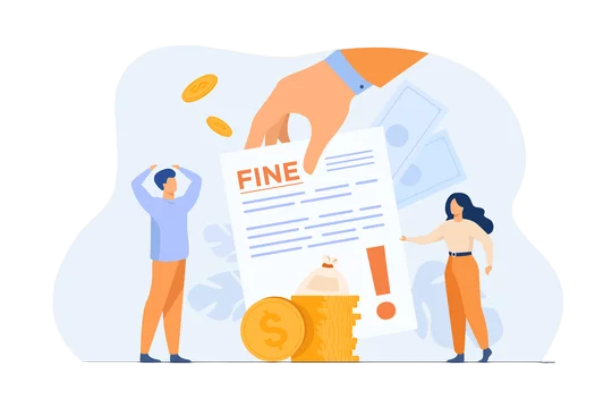
2. Reputation and Brand Image Risks
- Negative Publicity: Legal actions and non-compliance can attract negative media attention, damaging the brand’s reputation and public perception.
- Loss of Trust: Customers may lose trust in a brand that fails to provide an inclusive shopping experience, leading to a decline in customer loyalty and retention.
- Social Media Backlash: Negative experiences and legal issues related to accessibility can quickly spread on social media, amplifying the damage to the brand’s image.

3. Business and Operational Risks
- Reduced Customer Base: Inaccessibility can exclude a significant portion of the population with disabilities from using your site, leading to lost sales and reduced market reach.
- Decreased Competitiveness: Brands that fail to prioritize accessibility may fall behind competitors who provide an inclusive shopping experience, losing market share.
- Increased Operational Costs: Addressing accessibility issues reactively after a legal challenge or public complaint can be more costly and disruptive than proactively designing for accessibility from the outset.
4. Regulatory Risks
- Government Scrutiny: Non-compliance can attract scrutiny from regulatory bodies, leading to investigations and enforcement actions.
- Continuous Monitoring: Once a brand has been identified as non-compliant, it may be subject to ongoing monitoring and additional compliance requirements, increasing operational burdens.
The Benefits of ADA-compliance for your eCommerce Website
Achieving ADA compliance for your eCommerce website offers numerous benefits far beyond just meeting legal requirements. These benefits affect various different aspects of your business, including customer satisfaction, market reach, brand reputation, and overall business performance. Here’s a more in depth look at these benefits:
1. Enhanced User Experience
- Improved Navigation: ADA compliance typically involves making your website easier to navigate. This can benefit all users, not just those with disabilities, by improving the overall usability and functionality of your site.
- Accessible Content: Providing text alternatives for images, transcripts for videos, and providing readable fonts and contrast can make your content more accessible and enjoyable for everyone.
2. Increased Market Reach
- Broader Audience: Approximately 15% of the global population lives with some form of disability. By making your eCommerce site accessible, you open your business to a larger audience, potentially increasing your customer base.
- Inclusivity: ADA compliance ensures that individuals with disabilities can use your site, fostering inclusivity and equal access to your products and services.
4. Legal and Financial Benefits
- Avoiding Legal Issues: By complying with ADA requirements, you reduce the risk of lawsuits and the associated legal costs, fines, and settlements.
- Cost Savings: Proactively addressing accessibility can be more cost-effective than making reactive fixes following legal action or public complaints. Business owners could also be eligible for ADA tax credits.
4. Compliance with Global Standards
- International Reach: ADA compliance often aligns with international web accessibility standards, such as the Web Content Accessibility Guidelines (WCAG). This ensures your website is accessible to users globally, not just in the United States.
5. SEO and Website Performance
- Better SEO: Many accessibility improvements, such as providing alt text for images and creating a clear content structure, also enhance search engine optimization (SEO). This can improve your search engine rankings, driving more traffic to your site. Learn more about how accessibility and SEO intertwine here.
- Enhanced Performance: Accessible websites often load faster and perform better because they are designed to work well with various devices and internet speeds.
5. Improved Brand Reputation
- Positive Public Image: Demonstrating a commitment to accessibility enhances your brand’s reputation and public image. Customers appreciate businesses that prioritize inclusivity and social responsibility.
- Customer Trust and Loyalty: Providing an accessible and positive shopping experience can build trust and foster loyalty among all customers, including those with disabilities.
6. Competitive Advantage
- Market Differentiation: An accessible website can set your business apart from competitors who have not prioritized accessibility, providing a competitive edge.
- Innovation: Focusing on accessibility can drive innovation in how you design and deliver your products and services, leading to improved overall quality.
8. Corporate Social Responsibility (CSR)
- Ethical Business Practices: Embracing accessibility reflects your company’s commitment to ethical business practices and social responsibility, which can resonate positively with consumers and stakeholders.
Want to make sure your website is compliant with the Americans with Disabilities Act? Then unlock the ADA compliance checklist now. Discover actionable steps to ensure ADA compliance, helping you avoid lawsuits and any other negative consequences of non-compliance.
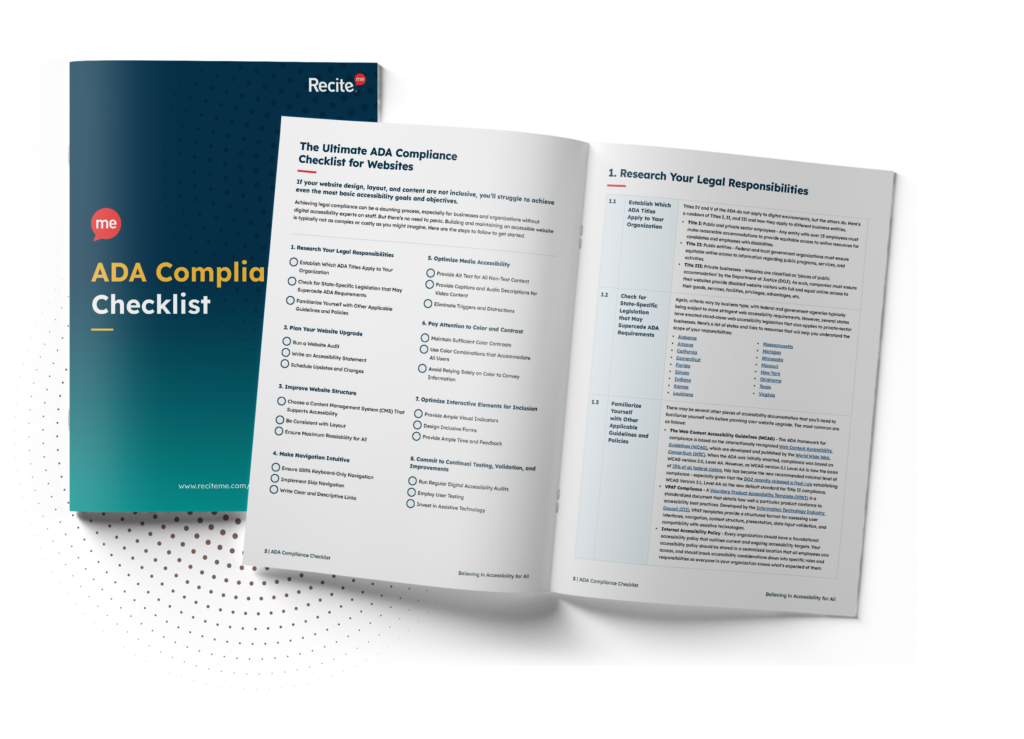
ADA-compliant Solutions and tools for eCommerce Websites
Our mission at Recite Me is to make the world a more accessible and inclusive place for people with disabilities. Undoubtedly, one of the ways we can achieve this goal is to become compliant with ADA requirements for businesses. Our range of accessibility tools have already helped various eCommerce brands start their journey accessibility journeys and become ADA compliance. So if you work for or own an eCommerce website in the United States we’ll be able to help you with the following products:
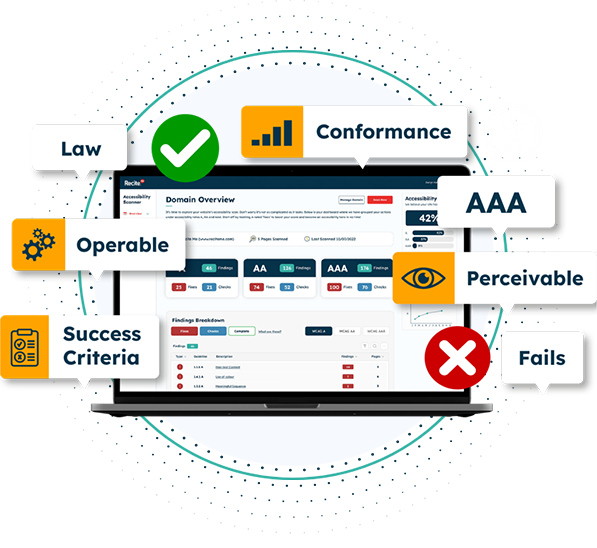
The Recite Me Accessibility Checker
Our Accessibility Checker can help address inaccessibility at its root cause. As the tool performs a complete scan of your website in line with the latest WCAG standards and guidelines. By following a simple four step process to help improve your websites accessibility:
- Step 1: Scan Your Domains – Choose between scanning single or multiple pages.
- Step 2: Identify Accessibility Issues – Identify the locations of accessibility issues on your website.
- Step 3: Fix Accessibility Errors – Boost your accessibility score by prioritizing fixes in line with WCAG Levels A, AA, and AAA.
- Step 4: Track Your Progress – Create and share custom reports with your team and roadmap the next issues in your fix queue.
Reach out and schedule a demo with our team today.
The Recite Me Accessibility Toolbar
The Recite Me Accessibility Toolbar is a simple software that installs on to your website to help make it more inclusive. This can be important for eCommerce stores as it allows users to customize your website in a way that works best for them. Some of the main features include:
- Personalising font size, type, and color options.
- Choosing the exact color contrast between the text and background.
- Utilizing the mask screen tool to help with focus.
- Using the ruler tool to make reading easier.
- Downloading content as an audio file as an alternative to reading.
- Converting page content into over 100 on-screen languages.
- Having the page read aloud in a choice of 65 languages.
- Customizing PDF documents or having them read aloud/ translated.
- Zooming in on any part of a webpage.
- Using the built-in spell-checker and a fully integrated dictionary and thesaurus.
Reach out and schedule a demo with our team today.

Need more help becoming ADA compliant?
The following resources are packed full of actionable tips and expert advice for making your digital content compliant with the Americans with Disabilities Act:
Free ADA Accessibility Training
Take the first step to ADA compliance by completing our training course.
Free ADA Accessibility Guide
Ensure your organization is meeting the requirements for ADA compliance.

